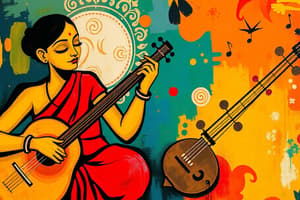Podcast
Questions and Answers
What are the characteristics of Carnatic music?
What are the characteristics of Carnatic music?
- Expansive improvisations
- Classical music of South India (correct)
- Built around precomposed Hindu devotional songs (correct)
- Modern music of North India
Which of the following describes Hindustani music?
Which of the following describes Hindustani music?
- More modern music of North India (correct)
- Dancing with specialist chanting
- Classical music of South India
- Repetitious with lots of gestures
What is a Bhajan?
What is a Bhajan?
A religious song in Hinduism.
The _______ system is a tradition where students live with their teacher to learn music.
The _______ system is a tradition where students live with their teacher to learn music.
What does the term 'Raga' refer to in Indian music?
What does the term 'Raga' refer to in Indian music?
Tala refers to a recurring time cycle in Indian music.
Tala refers to a recurring time cycle in Indian music.
Define the term 'Rasa' in Indian music.
Define the term 'Rasa' in Indian music.
What type of drum is used as a principal instrument in South Indian music?
What type of drum is used as a principal instrument in South Indian music?
Match the following terms with their descriptions:
Match the following terms with their descriptions:
Shona music is associated with the _______ ethnic group in Zimbabwe.
Shona music is associated with the _______ ethnic group in Zimbabwe.
BaAka music serves as a social critique within their communities.
BaAka music serves as a social critique within their communities.
What does the term 'Enculturation' refer to?
What does the term 'Enculturation' refer to?
What is the significance of the Melakarta system in Carnatic music?
What is the significance of the Melakarta system in Carnatic music?
Flashcards are hidden until you start studying
Study Notes
Carnatic vs Hindustani Music
- Carnatic music is the classical tradition of South India, emphasizing precomposed Hindu devotional songs.
- Hindustani music represents the more modern musical tradition of North India, characterized by expansive improvisation and dramatic contrasts in tempo.
Indian Music Characteristics
- Indian music showcases a diverse range, including pop influences reminiscent of Western music.
- Southern Carnatic music is largely pre-composed, while Northern Hindustani music features significant improvisation.
Functioning Layers in Carnatic Music
- Performance integrates dancing and chanting by specialists, characterized by repeated gestures and movements.
Bhajan
- Bhajan refers to devotional songs in the Hindu tradition.
Kriti Form and Sections
- Alapana: Introduction to Raga without rhythm.
- Tanam: Rhythmic exposition of the raga, marking the start of metric playing.
- Kriti: Main composed song where the drum enters.
- Kalpana Svaras: Imaginative notes that are subtle and hard to notice.
- Tani: Distinct drum solo, clearly apparent.
- Kriti: Concludes with a short ending.
Gurukula System
- Traditional educational system in India where students live with their teachers for extended periods to learn music and cultural practices.
Melakarta System
- Framework consisting of seven-note scales in Carnatic music.
Raga
- A foundational musical structure identified by its scale and specific embellishments, serving as a base for composition and improvisation.
Tala
- A recurring rhythmic cycle in Indian music, which can be tracked using hand and finger gestures.
Rasa
- Refers to the emotional response evoked by a piece of art, particularly in the context of Indian music.
Sruti
- A drone layer commonly produced on various Indian instruments during performances.
Tambura
- A plucked instrument similar to a mandolin, used mainly in Indian classical music.
Veena
- A seven-stringed lute that represents a significant instrument in South Indian classical music.
Mridangam
- The primary barrel-shaped drum of South India, characterized by its two-headed playing mechanism using palms and fingers.
Traditional Instruments of North India
- Tabla: A pair of drums made from wood and metal.
- Sitar: A plucked string instrument with 22 strings.
- Sarangi: A bowed string instrument.
- Sarod: A lute-like instrument utilized in Hindustani music.
African Music Characteristics
- African music is categorized into larger cultural zones, with individual identity shaped by numerous factors.
- Diverse ethnic groups, often referred to as tribes or kingdoms, influence the musical landscape across the continent.
Enculturation
- A gradual process where individuals gain cultural competence through community living, particularly during childhood.
Ewe and Agbekor
- Agbekor: Defined by call-and-response vocal styles addressing life challenges, alongside instrumental dance drumming with repetitive rhythms.
Dagbamba
- An ethnic group in Dagbon, known for their lineage of Lunsi drummers.
Griots
- African singers renowned for narrating tribal genealogies and histories through music.
Lunga
- An hourglass-shaped drum used by the Lunsi drummers, integral to the Dagbamba culture.
Gung-gong
- A carved cylindrical drum featuring snares on both heads, played by Lunsi.
Shona Music
- Ethnic group from Zimbabwe celebrated for their mbira music, a significant cultural expression.
Mbira
- A plucked idiophone instrument central to Shona musical traditions.
Chuning
- The specific tuning process of the mbira instrument.
BaAka Music
- Reflects the lifestyle of small, mobile communities in forested Africa; emphasizes communal social critique through music and limited instrumental use, focusing on vocal polyphony.
Mabo
- Music and dance associated with net hunting activities in the BaAka culture.
Eboka
- Represents a performance event within the Moba cultural framework.
Arab Music Characteristics
- Holds a vital role in intellectual life, characterized by the use of microtones and a blend of metric and non-metric rhythms.
Studying That Suits You
Use AI to generate personalized quizzes and flashcards to suit your learning preferences.



